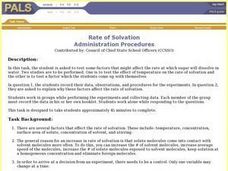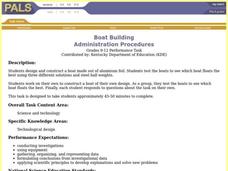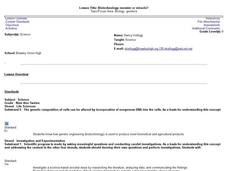Curated OER
Hidden in Plain View: History Standard Two and the Underground
Eighth graders create a quilt based on the Underground Railroad quilt code from the book Hidden in Plain View: A Secret Story of Quilts and the Underground Railroad.
Curated OER
Testing Carving Tools
Pupils onstruct an ancient bow drill and compare its effectiveness at carving stone to marks made by other tools. They perform a careful analysis of the performance of each tool.
Curated OER
Organization and Study Skills
Young scholars with special needs utilize organizational skills such as what supplies to bring to class, how to use an assignment notebook, and how long it takes to complete an assignment. They become more independent students, become...
Curated OER
Computer Technology
Students comprehend a basic knowledge of computers, Word, Excel, and PowerPoint 2002. They study to practice taking the State Competency Test. Students review vocabulary flash cards to assist them.
Curated OER
Book Search
Fourth graders are introduced to how to use the Dewey Decimal System in libraries. After taking a pre-test, they complete a worksheet in which they determine the location of different books on the internet and on the shelf. To end the...
Curated OER
Writing a Research Paper
Students work through the steps of writing a research paper in this lesson. They define their problem and decide what sources of information to use. They read, take notes, and organize the collected data. Finally, they write the...
Curated OER
Forest Stewardship
Students define the term forest stewardship and they identify good forest stewardship practices. They are asked:"Does anyone enjoy spending time in the woods?" Students identify techniques of practicing good forest stewardship (taking...
Curated OER
Personal Learning Profile
Students, after completing a Personal Learning Profile pre-test Survey, take a Personal Learning Profile pre-test. They explore personal interests, spiritual beliefs, strengths, needs, and habits. The questionnaire is completed on the...
Curated OER
Rate of Solvation
Students test factors that may affect the rate at which sugar dissolve in water. They conduct two studies: One is to test the effect of temperature on the rate of solvation and the other is to test a factor which Students come up with...
Curated OER
Do Different Colors Absorb Heat Better?
Students work together to test how the color of a material affects how much heat it absorbs. They make predictions and take notes on their observations. They discover how engineers use this type of information.
Curated OER
Does Weight Affect Drag?
Learners investigate how weight affects a parachute's rate of fall. In this investigative lesson students test parachutes, average results and conclude what makes a faster descent.
Curated OER
Maple Syrup Production
Students examine the steps of maple sugar production and the labor and effort involved from the tree to the final product. They participate in a taste test game, and if they have access to maple trees, make their own syrup and sugar.
Curated OER
Personality and Posts
Students examine the personality type needed to become a diplomat in the US Foreign Service. They look at the results of the Myers-Briggs Personality Test that each diplomat in training must take. They study their own personality type to...
Curated OER
Water-holding Capacity of Earth Materials
Students design and conduct an experiment to test their ideas about how to speed up or slow down the rate of an enzyme-catalyzed reaction. They have access to an array of physical and chemical factors that might influence enzyme...
Curated OER
The Nutritional Content of Food
High schoolers are given three unknown samples and must perform two chemical tests in order to determine if the samples contains protein and/or starch. Students work with corrosive or toxic reagents.
Curated OER
Temperature and Enzymes
Students compare the times it takes the milk in each of two cups to curdle. They are told that an enzyme that is added to the milk, rennin, is involved in the natural curdling process of milk. Students are asked to consider what...
Curated OER
States of Matter Mini-Unit
Students identify he phases of matter (solid, liquid, gas), and why they take place. They comprehend what a physical change is and what a chemical change is. Students know the difference between a Mixture and a Solution.
Curated OER
Crustal Sinking
Students measure the rate of sinking of a test tube into a beaker of "glop", representing a model of the interaction between the Earth's crust and upper mantle. This task assesses students' abilities to make simple observations,...
Curated OER
Is There Life Before 121?
Students observe microbial growth in the lab. In this biology lesson, students determine the conditions suitable for bacterial growth. They explain the methods of sterilization and bioburden testing.
Curated OER
Boat Building
Students design and contrast a boat made out of aluminum foil. They test the boats to see which boat floats the best using three different solutions and steel ball weights. Students work on their own to construct a boat of their own...
Curated OER
Quick Breads, Pancake/Waffle Lab
Pupils explore the bread, cereal, grain food group on the Food Guide Pyramid. They test recipes for quick breads which are high in carbohydrates and determine the purpose of each of the ingredients in pancakes or waffles.
Curated OER
A Tree is an Ecosystem
Young scholars make observations about trees. In this ecosystem lesson, students observe and record all living and non living things they find under a tree, look for birds nests, evidence of woodpeckers and take samples such as leafs,...
Curated OER
Biotechnology: Monster or Miracle
Students explore biotechnology. For this scenario-based lesson, students take a survey on what they know about genetic engineering, view a PowerPoint, and conduct a web quest. Students will then be placed in groups, and produce one of...
Curated OER
Monitoring Energy Expenditure
Students use heart rate monitors and complete a swimming and running test. These tests allow students to obtain personal data, to manipulate the data through calculations of various parameters, and to graphically represent the data.

























